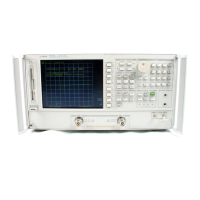Chapter 2 41
Quick Start: Learning How to Make Measurements
Learning to Make Reflection Measurements
Learning to Make Reflection Measurements
This example procedure shows you how to measure the reflection response of a bandpass
filter. The measurement parameter values listed are unique to this particular test device.
For further measurement examples, refer to the "Making Measurements" chapter in the
HP 8753E Network Analyzer User's Guide.
NOTE Reflection measurements monitor only one port of a test device. When a
test device has more than one port, you must ensure that the unused
port(s) are terminated in their characteristic impedance (for example,
50Ω or 75Ω). If you do not terminate unused ports, reflections from
these ports will cause measurement errors.
You can connect an unused device port to the unused analyzer test port,
to act as a termination. For example: when you are measuring S
11
or
S
22
, you can connect an unused device port to the analyzer's PORT 2 or
PORT 1, respectively.
The signal reflected from the device under test is measured as a ratio of the reflected
energy versus the incident energy. It can be expressed as reflection coefficient, return loss,
or standing-wave-ratio (SWR). These measurements are mathematically defined as
follows:
reflection coefficient (Γ) = reflected voltage / incident voltage
= S
11
or S
22
(magnitude and phase)
magnitude of reflection = |Γ|
coefficient (ρ)
return loss (dB) = −20 log (ρ), where (ρ) = |Γ|
standing-wave-ratio (SWR) = V
maximum
/ V
minimum
= (1 + ρ) / (1 −ρ)

